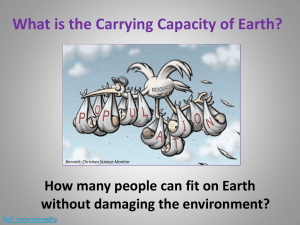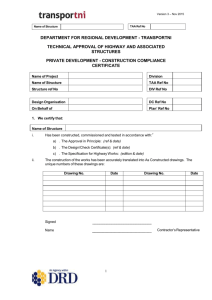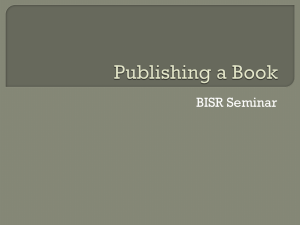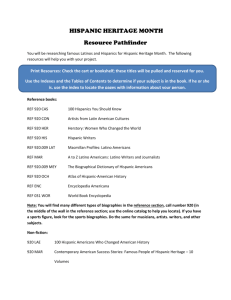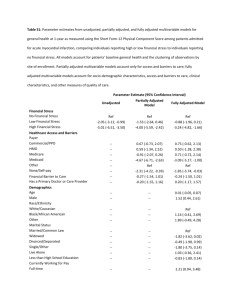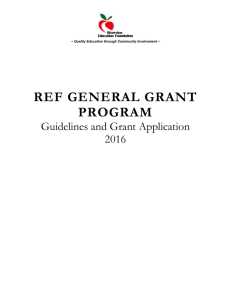Business Case Report Template (May 2008)
advertisement
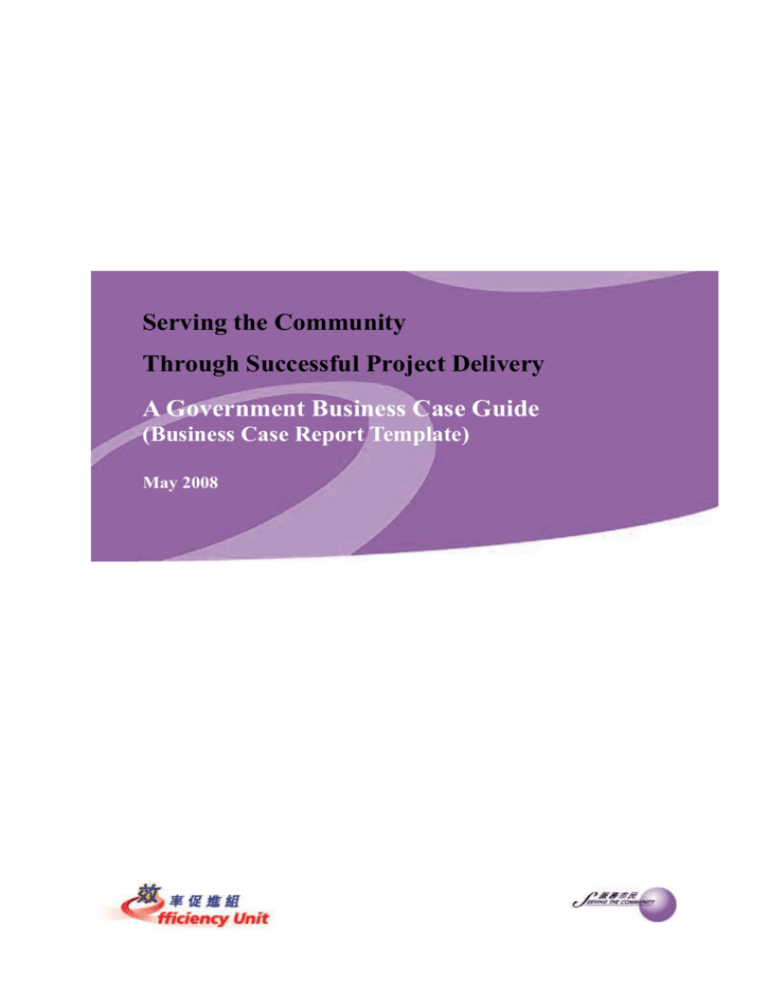
Serving the Community Through Successful Project Delivery A Government Business Case Guide (Business Case Report Template) May 2008 How to Use this Template This template is to give a suggested layout and content for a Business Case Report. The template is formatted to follow the same structure and general numbering scheme as used for the layout of the Government Business Case Guide. A short description of the suggested contents of each section is given, together with suggested table layouts and content. 1 EXECUTIVE SUMMARY This summary provides the salient points of the Business Case in terms of: • The key reasons for doing the project • The current service provision, if applicable • The key future requirements • A summary of the full list of options • A summary of the options selection procedure and the options chosen for detailed examination • A summary of the comparative findings and justification for the preferred option • Highlights of the Implementation Plan • A statement to seek approval. 2 ANALYSIS OF REQUIREMENTS 2.1 The Strategic Overview and Context Provide an overview here of the service or project, including strategic aims, policies and outcomes. 2.2 Project Objectives State the policy objectives that the project is required to meet. 2.3 The Current Service Provision Analyse the current status and the issues with the current service. This service provision information should be presented in an easily understood and comparable format such as a table format (see Table 1). Where flowcharts or other graphical techniques are used, keep the graphics simple and easily understood. The Business Case should contain a summary of the findings, and may refer to more detailed documentation or Appendices as backup information. Table 1 – Current Service Provision Raised By Name of person Ref No. Unique number Name Short description of the requirement Summary Longer description Rationale Reason for the requirement 2.4 Future Requirements Analyse what the desired future service level(s) should be by collecting requirements from the key stakeholders. Bear in mind that the Business Case is looking for high level requirements so do not go into too much detail. However, enough detail is required to be able to make reasonable decisions later in the Business Case process. If possible try to present the information in the same format as any service provisions were documented as this will make it easier to make comparisons later in the process. Table 2 – Future Requirements Table Raised By Name of person raising the requirement Ref No. Unique number Name Short description of the requirement Summary Longer description Rationale Reason for the requirement 2.5 Gap Analysis Match future requirements against any current service levels and identify the gaps that need to be addressed. Table 3 – Gap Analysis Output Current Service Ref No. Current service provision Future Service Ref No. Future requirement Gap Difference between what happens now and what is required in the future 2.6 Priority of the Requirements Add an additional column to Table 3 and put the results of the MOSCOW analysis in the column. Table 3 can be skipped and the information presented directly in the Table 4 format to avoid duplication in the Business Case. Table 4 - Prioritisation of the Requirements / Gaps Current Service Future Service Gap Ref No. Current service provision Ref No. Future requirement Identify the difference between what happens now and what is required in the future MOSCOW Priority Must Have; or Should Have; or Could Have; or Won’t Have 2.7 The List of Requirements to be Delivered Either add an additional column to Table 4 to indicate which requirements will be delivered or describe in a separate table or narrative format which requirements will be delivered in the project. It is preferable to build on an existing table in order to avoid duplication of presented data, in which case Tables 3 and 4 may be skipped and a single table presented as shown in Table 5. Table 5 – Combined Gap Analysis / MOSCOW / Deliverables Table Current Future Gap MOSCOW Included in Service Service Priority Project Ref No. Ref No. Difference between Must Have; or Yes or No Current Future what happens now Should Have; or service requirement and what is required Could Have; or provision in the future Won’t Have 3 OPTIONS SELECTION AND EVALUATION 3.1 Evaluation Criteria State criteria for evaluating the benefits of the various options. Define these criteria in advance of identifying the options to avoid undue influence of the options. 3.2 Identifying Available Options State the available options and describe how the various options were identified, what methodology was used and why some options were discarded early (if any). 3.3 Initial Evaluation and Consolidation Explain how the shortlisted options were chosen and what options were shortlisted. A typical summary table of the outcome of the process is provided below. Table 6 - Initial Evaluation Outcome Criteria Evaluation criteria 1 Evaluation criteria 2 Evaluation outcome Option 1 Result – Meet, Marginally satisfy, or Don’t meet Option 2 Option 3 Preferred/ Carried forward/ Discarded 3.4 Detailed Options Analysis Provide an overview of the evaluation methodology in this section. Option 4 3.4.1 Benefits Evaluation Quantitative as well as qualitative benefits for each option should be considered and the process and outcomes of these discussed here. 3.4.2 Cost Evaluation Discuss the various costing elements that were evaluated. Details regarding the assumptions used and the outcome of the evaluation should be presented. Cost elements typically include the following: 3.4.2.1 Non-recurrent Costs Describe the non-recurrent costs (or one off cost to establish the option) elements, including the transition cost, and the basis for deriving these costs. 3.4.2.2 Recurrent Costs Provide a description of costs that will be incurred throughout the life of the project. These costs may either be fixed or variable. 3.4.2.3 Opportunity Cost Describe the opportunity cost of the project. Opportunity cost is the cost of the next best foregone alternative to deliver a given option. It is typically considered in larger and complex projects where the true economic cost of a project needs to be assessed. 3.4.2.4 Whole of Life Costs Describe and include costs that will be incurred over the life of the project to ensure that the assets originally procured can continue to be delivered to a level of service that provides the required outcomes. The whole of life costs may include activities such as replacement of assets, refurbishing or upgrading specific asset elements. 3.4.2.5 Optimism Bias Discuss areas where the project team may have been overly optimistic (or pessimistic) and what measures have been included to address any potential bias. 3.4.3 Strengths and Weaknesses Evaluation Discuss the strengths and weaknesses of the options considered. 3.4.4 Risk Analysis Describe the process used for risk identification, risk quantification as well as key observations from this aspect. Detail any findings in a risk register. 3.4.5 Sensitivity Analysis Discuss the findings of any sensitivity analysis carried out to determine how sensitive the outcome of the analysis is to variations in the assumptions. Put any detailed tables in an Appendix. Suggested format of a results table is: Table 7 – Sensitivity Analysis Results Assumption Variance Results 1 Reductions in assumption Result Baseline assumption Increases in assumption Result Variance Results 2 Result Variance Results 3 etc Result Result Result 3.5 The Preferred Option Discuss and summarise the overall options analysis and the result. Table 8 - Summary Table for Selection of Preferred Option Evaluation Areas NPV Non-financial benefits appraisal ranking Strengths Weaknesses Non-financial risk appraisal Overall ranking 4 Option 1 Option 2 Option 3 IMPLEMENTATION PLANNING Describe how the chosen option will be delivered and rolled out and the various issues that will have to be considered. 4.1 Project Structure and Governance Detail how the project will be managed and governed. 4.1.1 Governance Describe the chosen governance structure for the project, include information on individuals or positions that are already identified. 4.1.2 Project Management Describe the project management methodologies that will be used in delivering the project, including where available, a high level description of the organisational structure (could be graphical). 4.2 Implementation Detail Detail the programme and transition arrangements. 4.2.1 Implementation Timing Include a high level implementation programme. This could cover single-stage or multi-stage delivery of the project. Present as a Gantt chart. 4.2.2 Transition Planning Describe the activities and temporary arrangements required during the transitional phase. 4.3 Constraints, Assumptions, Sourcing and Funding Requirements 4.3.1 Constraints and Assumptions Document identified constraints and the major assumptions made which affect the implementation. May be presented in a table format. Table 9 – Constraints and Assumptions Item CONSTRAINTS Short description ASSUMPTIONS Short description 4.3.2 Description Long description Long description Sourcing and Procurement Strategy Describe the chosen sourcing models with reasons why they were chosen and how goods and services will be procured and tracked. 4.3.3 Funding Requirements Describe what funding requirements are required, the timing, source and application/approval arrangements of the funds. 4.4 Approach to Manage Risk, Communications and Resources 4.4.1 Risk Management Describe the risk management plan with detailed responsibilities and actions. 4.4.2 Communications Strategy Describe the required communications strategy together with what to communicate, to whom and when. Suggested format is in Table 10. Table 10 – Communications Strategy Item Medium Audience Report type 4.4.3 Paper, TV etc. Who the report is for Frequency Monthly, weekly etc. Purpose of Communication Why the communication is needed Staff Resources Detail what are the key issues, particularly from a human resources management point of view. This could include both staffing requirements for the project together with any impact caused by the project such as staff re-deployment or reductions/increases. 4.5 Technical, Environmental & Heritage Considerations 4.5.1 Technical Considerations Describe any technical considerations, which could range from ICT requirements to general or specific engineering requirements. 4.5.2 Environmental Considerations Describe any environmental considerations that have to be borne in mind and planned for. Where an EIA is required, an estimated duration should be included here. 4.5.3 Heritage Preservation Considerations Describe any predicted cultural and heritage issues. 4.6 Regulatory or Legislative Impacts 4.6.1 Regulatory Impact Assessment / Business Impact Assessment Any impact on any regulatory bodies or regulated or third party businesses which could be adversely or positively affected by the introduction of the project should be included. 4.6.2 Legislative Considerations Detail any legislative aspects to the project that could require legislative changes or issue of new guidelines/codes of practice. 4.7 Other Considerations and Implications State any other considerations that do not fit into the above categories. An example could be recommendations for further work or projects. 4.8 The Post Implementation Review Process Explain how and when reviews will be carried out to check that the expected benefits have been realised and delivered. Also describe how to track the benefits and report on them versus the original analysis.


